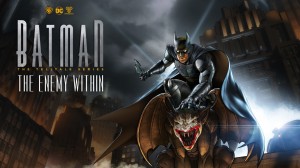Review for Batman: The Enemy Within – The Telltale Series page 2
Telltale are prolific when it comes to releasing games, usually having multiple series on the go at once. Still, it was a surprise when the second season of Batman: The Telltale Series kicked off so soon after the conclusion of the first. It seems that crime never rests in Gotham. The Enemy Within gets off to a solid start, with the first of five episodes actually improving on what came before it, starting with a bang and introducing a bunch of intriguing new characters and twists. Unfortunately, the subsequent episodes suggest that there should have been more time spent preparing this new outing for the Caped Crusader. It’s fun to both brawl as Batman and battle public perception as Bruce Wayne, but the absorbing opening quickly boils down to a primary focus on The Joker, leaving many other promising storylines behind or just too dull and weak to matter much in comparison.
It all starts out harmlessly enough: A suave man kitted out with high-tech gadgets is scouting a casino floor. No, this isn’t James Bond, though it’s an obvious comparison to make. This is Bruce Wayne, keeping an eye on the plump Rumi Mori, a magnate who made his money through arms dealing and has now diversified into biotech. With his trusty butler and surrogate father Alfred talking into his ear from the Batcave, our protagonist is here trying to find evidence of Mori’s shady dealings, and players do some light snooping by clicking highlighted objects to get Bruce’s thoughts on them.
Of course, it doesn’t take long for everyone in the casino to get more than they bargained for when a man in a green hood and domino mask bursts onto the scene posing the question: “I begin and have no end. And I end all that begins. Who am I?” The answer to that conundrum is Death – or as you’ll come to know him, The Riddler. Depicted countless times across comics, television and film through the years, this take on the enigma-obsessed villain is a great one. With his greying hair, growling voice and metal-hooked cane, we learn that this Riddler terrorised Gotham in the past, only to suddenly disappear. Now that he’s back, he’s determined to make a strong impression, immediately slashing throats and destroying buildings to wreak havoc. This is a violent, scary portrayal of a man who may not have Batman’s strength, but has an equal amount of ingenuity.
There’s no time for polite introductions. With the threat level red, Bruce switches into his alter ego and dons his powerful black suit. The first season had superb action sequences and it’s no different this time. With music beating in the background, Batman jumps, kicks and punches seemingly with ease. From a gameplay perspective, the fights mostly consist of pushing the right buttons when prompted, though there’s a neat new element that lets you make tactical decisions on the fly, like choosing how to protect a hostage or take down an enemy. Previously this was planned in advance, leaving you to watch the results play out, but doing it in the moment is much more effective and maintains a stronger pace.
What particularly stands out during combat sequences is the audio-visual presentation. These scenes make constant but effective use of slow motion, holding on a stylish shot while you follow the corresponding on-screen prompts. Every bit of physical contact is keenly felt, the flying blood and loud thuds lending authenticity to the pain. And thanks to quick (yet never disorienting) camera switches and spins, along with Batman’s penchant for gadgets and his repertoire of fight moves, such encounters never grow stale. Full-blown action sequences are sparingly used in each episode, so they’re a joy to behold and engaging to play every time.
The Riddler may be the first, but he certainly isn’t the only foe you’ll encounter, including several from the classic Batman rogues’ gallery. Sticking its nose into everything is a mysterious unnamed agency helmed by the no-nonsense Amanda Waller. This stout, middle-aged woman has her fingers in many pies, gathering intelligence not only on Gotham’s scum, but also on Bruce and Batman. She rubs Commissioner Gordon the wrong way, overruling him and taking over his cases. Her agency’s presence proves interesting in a subversive way, posing a threat to Batman with the information and power they hold, and how you respond to it will impact your relationship with Gordon.
A key exchange with Waller early on shapes the entire season. With Amanda gaining an advantage over Bruce, he’s forced to infiltrate Gotham’s underworld to try to figure out what The Riddler is up to. In this role, Bruce slings around sans cowl with familiar criminals like Harley Quinn, Mr. Freeze and Bane. The latter two don’t veer far from how they’ve been characterised elsewhere, nor are they particularly interesting. Bane is especially weak, which is ironic considering he’s nothing more than a bulky muscle man. Of the trio, Harley Quinn is undoubtedly the best as the leader of the pack. She’s fierce and commanding and is especially intimidating when you’re alone with her.
The problem is that being part of this gang is mostly dull, apart from when fights break out. They spend too much of their time in a boring concrete hideout, occasionally popping out to cause some mischief, all based around an uninspired storyline about a virus they want to release in Gotham. Also, I know the entire Batman franchise requires suspension of disbelief, but the idea of Bruce becoming part of their crew just isn’t realistic. Billionaire businessman dons a flat cap and leather jacket, wears an earpiece, and brawls suspiciously like that pesky winged crimefighter… and yet none of them puts the pieces together? A scene in Wayne Enterprises where Bruce and two key gang members terrorise one of his employees with a sledgehammer is particularly ridiculous, feeling like a poor attempt to create tension.
Selina Kyle, better known as Catwoman, makes a welcome return but her character is all over the place, with behaviour so erratic that it becomes irritating. One moment you’ll be extremely close to her, the next she’ll be trying to kick you in the face. You could perhaps chalk this up to who she is, but it’s a step backwards considering the progress Bruce made with her in the previous season. I’m not entirely sure if Telltale know what to do with her character anymore. She often seems to be present just to serve a functional purpose rather than add to the story. It’s a shame, since there’s opportunity for Selina to help explore an unseen side of both Bruce and Batman, but it never amounts to anything.
The real star of the show isn’t ultimately Bruce/Batman but John Doe, the green-haired, wild-grinned young man introduced in season one but now free of Arkham Asylum and part of Harley Quinn’s gang. When we first meet him here he’s not yet a mass-murdering lunatic like The Joker is traditionally portrayed. Instead, while slightly unstable, John is initially more socially inappropriate than anything. His wide eyes suggest menace, as does his unhealthy latching onto Bruce, but there’s no solid proof that he’s up to no good… yet.
The scenes between these two are always excellent. John is fighting inner demons and wants to do his best to please Bruce (who he suspects is Batman, with or without confirmation) but sometimes these traits don’t play well together. A café scene where Bruce teaches John how to talk to Harley is memorably amusing, while later a glowing funhouse plays host to a shining example of how unsettling John can be. Thanks also to strong voice acting for a man who sounds like he could fly off the hook at any moment, I really liked the character of John.
As Bruce, you get to have a real impact on shaping John’s trajectory: Will he become a villain or vigilante? I found myself feeling sympathetic towards John, since he means well but struggles to show it without violence. I did my best to make them friends and keep John on a noble path, but it’s a fine balancing act, especially since your actions might not be interpreted by John as you intend. The direction you choose culminates in the final episode, which is basically two in one – depending on how John has turned out, you could play a nearly entirely different episode. Not just minor dialogue changes either, as the story itself is radically different. For years Telltale have been wanting us to believe that our choices matter in their games, and this is a fantastic example of that being true. I’ve always felt that such decision-making was a gimmick, albeit a convincing illusory one, but it finally pays off. That said, while this adds great replayability to the finale, you’ll need to replay at least the prior episode to get the alternate path, and the inability to skip dialogue remains a frustration.
Receiving a notification that a character “will remember that” has been a common staple of these games for a long time, but now there’s a new message added to the mix – that your relationship with someone has changed. At the end of each episode you’ll get a summary of how you’ve affected certain people and why. For example, in one episode I made Harley angry and in another I saw Gordon become steadfast. This is an interesting wrinkle and it’s good to see how it impacts your interactions with these people. While some are more minor than others, characters bringing up past conversations or treating you a certain way because of your actions is always a nice touch.
As usual, you guide most of these encounters by selecting one of four dialogue options against the clock. It’s nothing new at this point, but I still find it an enjoyable way to experience the story. For example, you can choose whether to be coy, direct or imposing, and those you’re conversing with will react accordingly, though your responses often only alter the next couple of lines. Then there are those choices that hold greater weight: Do you lie to a loved one or tell them the harsh truth? Do you choose to reveal key intel to Waller? Such dilemmas result not only in immediate consequences but can even impact future episodes. You’ll ponder and overthink every one of these decisions, which is a credit to the characters and world-building presented.
Making all this believable is the generally solid conversational writing; while I have quibbles with the overall plot structure, many of the actual discourses are well written. There are a few clumsy lines, particularly those shoehorned in for exposition, but nearly every character you meet is suitably defined. You’ll feel like you’re interacting with distinct personalities, plus playing both sides of Bruce and Batman adds welcome depth – as the former you’re the smooth businessman, the latter a fierce vigilante. (Nothing is cooler than when you get the chance to silently grapple away from someone as Batman.) While this is a serious take on the character, there are a couple moments of light relief, like when John awkwardly tries to squeeze around Bruce. There’s enough gentle humour sprinkled throughout the season that it works nicely in contrasting the overall darkness.
When you’re not talking or fighting, you get to be a detective. Sadly, this is the weakest part of the experience. The concept is fine, but the execution falls flat. The process involves linking elements together to solve a mystery. For instance, you discover a body at a crime scene and need to work out what caused the death. The issue is that you don’t need to use logic here at all – just examine everything (there are no optional hotspots) and then connect the hotspots together in obvious pairs. Other investigative teases are offered elsewhere, like supposedly using your phone to scan objects and build up a full fingerprint, but even this requires no more engagement than the Quick Time Events during action scenes. I crave some sort of challenge to make me feel like I’m tapping into the vaunted brain of the “World’s Greatest Detective”.
The lack of any real intellectual stimulation is highlighted right away by the presence of The Riddler. His whole modus operandi is presenting enigmas – he’s arrogant, thinking he’s outsmarted you, so cracking them can advance your investigation or even save your life. This is the perfect setup for some thought-provoking challenge, but it’s entirely wasted. Near the beginning of the game you’ll get one of his mechanical boxes, adorned with a question mark, and answering a riddle can help you open it. But when it’s solved by interacting with one of the few nearby hotspots, which you pointedly used only minutes before, it’s eye-roll inducing. I know gameplay difficulty has never been the primary concern of these interactive tales, but more effort should at least be made where the situation actually warrants it.
As you might expect from a Batman adventure, much of the game is set at night or in dimly lit rooms, which works in favour of the art style. The Dark Knight himself looks downright awesome whenever he appears in his full suit with glowing eyes. The thick outlines and simple textures add to the comic book aesthetic, despite the mostly realistic settings that range from a church to a ship. These places feel rundown and grimy, which suits this universe. Disappointingly, many of the same locations crop up time and time again. Gotham is meant to be a huge, sprawling city, but you could have fooled me considering how similar every alleyway looks or how often you end up on the same rooftop or room in Wayne manor. Presumably this is due to budget and time constraints, but it gets monotonous. What we get is serviceable, but it would have been better to push the boundaries a bit more. This is especially noticeable in an early location associated with The Riddler, which does nothing more than make clichéd use of some TV sets.
Regular composer Jared Emerson-Johnson is back again, dishing up another excellent score. During sombre investigation periods, strings slowly strum and echo in the background, with soft drums building as you progress. Elsewhere, throughout a particularly trying conversation there’s a more electronic and reverberating approach, adding tension to the scene. Perhaps the most outstanding piece accompanies the opening fight, a fast-paced orchestral track that keeps the urgency and crescendos in perfect time with the action.
It shouldn’t need to be mentioned as a positive, but it’s worth noting that I experienced no technical issues throughout. The previous season was plagued with slowdowns for me, even on powerful computers, but thankfully that’s vanished here. While the lip syncing still could do with some improvement, this is a definite step in the right direction.
Each of The Enemy Within's five episodes clock in at an average of 90 minutes, which makes for a satisfying runtime altogether. The experience itself isn’t quite so satisfying, however. Despite a powerful start, with interesting characters and the promise of a mysterious plot, the story quickly dissolves. I became bored spending time as Bruce, which is a shame since exploring the man behind the mask is rife with possibility. Scheming with the criminals of Gotham sounds like an interesting twist, but it’s never as fun as it should be. And as you’d expect from this developer, for better or worse the entire experience is light on gameplay, heavy on cinematic dialogue. The news isn’t all bad, of course. The action is consistently enthralling, many conversations are engaging (especially with John) and the audio is excellent. If you like the Batman franchise, and especially if you enjoyed the previous season from Telltale, you’ll probably find enough to entertain you here too. And to cap things off, the final decision involving Alfred is a juicy one – so much so that if the Caped Crusader does make a third episodic outing, it’ll be hard to resist seeing where the story goes from here.
WHERE CAN I DOWNLOAD Batman: The Enemy Within – The Telltale Series
Batman: The Enemy Within – The Telltale Series is available at:
- GOG -60%
- Steam
- HumbleBundle
































